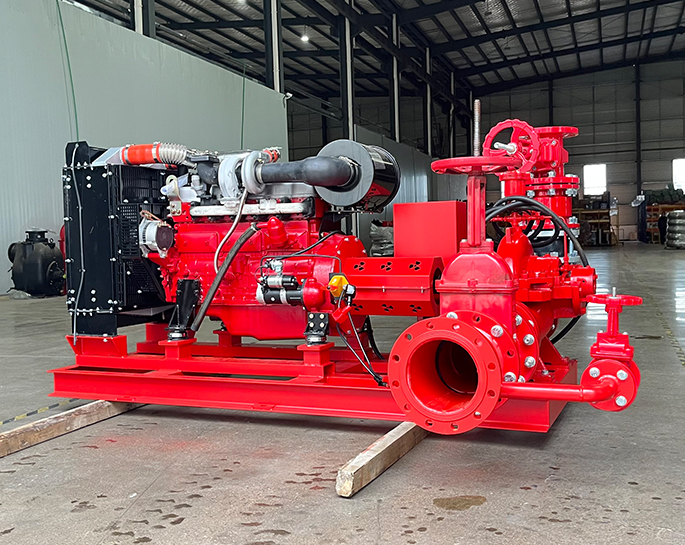What is the purpose of a fire pump acceptance test?
Dec 25, 2023
Share:
A fire pump acceptance test is conducted to ensure that a newly installed or modified fire pump system meets the required performance standards and specifications. The purpose of this test is to verify that the fire pump is capable of delivering the necessary water flow and pressure as per the design criteria and applicable codes and standards. The acceptance test is a critical step in the commissioning process of a fire protection system, and it helps ensure the reliability and effectiveness of the fire pump in emergency situations.
Key purposes of a fire pump acceptance test include:
1. **Verification of Design Criteria:**
- The acceptance test confirms that the fire pump system meets the design criteria specified by the engineer or designer. This includes factors such as flow rate, pressure, and other performance parameters.
2. **Compliance with Standards:**
- The test ensures that the fire pump and associated components comply with relevant industry standards and codes, such as those established by the National Fire Protection Association (NFPA) or local regulatory authorities.
3. **Identification of Deficiencies:**
- The acceptance test helps identify any deficiencies or issues in the fire pump system that may need to be addressed before the system is put into service. This includes issues related to pump performance, controls, power supply, and other critical components.
4. **Verification of Control Systems:**
- The test assesses the functionality of the fire pump controller, including its ability to start and stop the pump automatically, maintain pressure, and respond to various conditions.
5. **Testing of Alarms and Signals:**
- Alarm and signaling systems associated with the fire pump are tested to ensure that they function correctly and provide timely alerts in the event of pump failure or other issues.
6. **Documentation Verification:**
- The acceptance test includes a review of documentation, such as pump curves, test procedures, and record-keeping requirements. This helps ensure that the necessary documentation is complete and accurate.
7. **Performance under Various Conditions:**
- The fire pump is tested under various operating conditions, including full load, partial load, and low flow conditions, to assess its performance across a range of scenarios.
8. **Confirmation of Safety Features:**
- Safety features, such as over-speed protection, pressure relief valves, and other protective measures, are verified during the acceptance test to ensure the safety of the system.
9. **Training Opportunities:**
- The acceptance test may provide an opportunity for training personnel responsible for operating and maintaining the fire pump system. Training can cover system operation, troubleshooting, and emergency response procedures.
10. **System Integration:**
- If the fire pump is part of an integrated fire protection system, the acceptance test may also verify its integration with other components, such as fire alarms, sprinklers, and emergency power systems.
Conducting a thorough acceptance test is essential to confirm the reliability and functionality of the fire pump system before it is put into service. This helps ensure that the system will perform as intended in the event of a fire emergency.

Key purposes of a fire pump acceptance test include:
1. **Verification of Design Criteria:**
- The acceptance test confirms that the fire pump system meets the design criteria specified by the engineer or designer. This includes factors such as flow rate, pressure, and other performance parameters.
2. **Compliance with Standards:**
- The test ensures that the fire pump and associated components comply with relevant industry standards and codes, such as those established by the National Fire Protection Association (NFPA) or local regulatory authorities.
3. **Identification of Deficiencies:**
- The acceptance test helps identify any deficiencies or issues in the fire pump system that may need to be addressed before the system is put into service. This includes issues related to pump performance, controls, power supply, and other critical components.
4. **Verification of Control Systems:**
- The test assesses the functionality of the fire pump controller, including its ability to start and stop the pump automatically, maintain pressure, and respond to various conditions.
5. **Testing of Alarms and Signals:**
- Alarm and signaling systems associated with the fire pump are tested to ensure that they function correctly and provide timely alerts in the event of pump failure or other issues.
6. **Documentation Verification:**
- The acceptance test includes a review of documentation, such as pump curves, test procedures, and record-keeping requirements. This helps ensure that the necessary documentation is complete and accurate.
7. **Performance under Various Conditions:**
- The fire pump is tested under various operating conditions, including full load, partial load, and low flow conditions, to assess its performance across a range of scenarios.
8. **Confirmation of Safety Features:**
- Safety features, such as over-speed protection, pressure relief valves, and other protective measures, are verified during the acceptance test to ensure the safety of the system.
9. **Training Opportunities:**
- The acceptance test may provide an opportunity for training personnel responsible for operating and maintaining the fire pump system. Training can cover system operation, troubleshooting, and emergency response procedures.
10. **System Integration:**
- If the fire pump is part of an integrated fire protection system, the acceptance test may also verify its integration with other components, such as fire alarms, sprinklers, and emergency power systems.
Conducting a thorough acceptance test is essential to confirm the reliability and functionality of the fire pump system before it is put into service. This helps ensure that the system will perform as intended in the event of a fire emergency.







